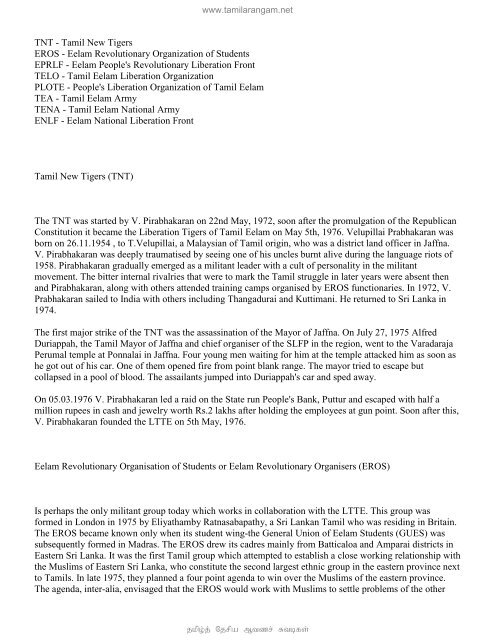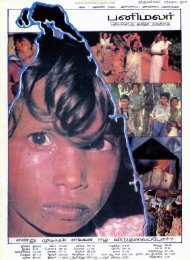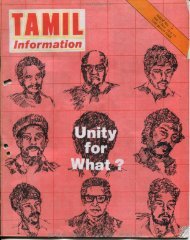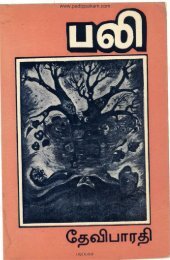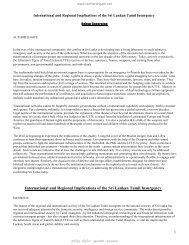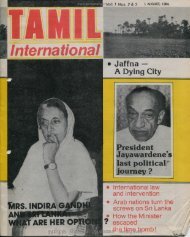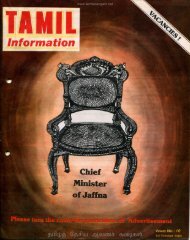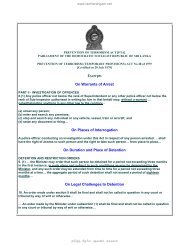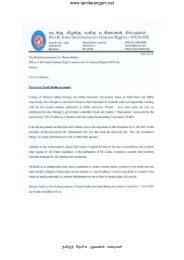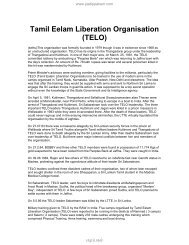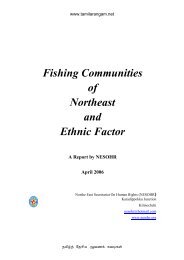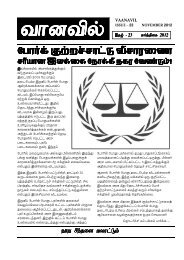TNT - Tamil New Tigers
TNT - Tamil New Tigers
TNT - Tamil New Tigers
Create successful ePaper yourself
Turn your PDF publications into a flip-book with our unique Google optimized e-Paper software.
www.tamilarangam.net<br />
<strong>TNT</strong> - <strong>Tamil</strong> <strong>New</strong> <strong>Tigers</strong><br />
EROS - Eelam Revolutionary Organization of Students<br />
EPRLF - Eelam People's Revolutionary Liberation Front<br />
TELO - <strong>Tamil</strong> Eelam Liberation Organization<br />
PLOTE - People's Liberation Organization of <strong>Tamil</strong> Eelam<br />
TEA - <strong>Tamil</strong> Eelam Army<br />
TENA - <strong>Tamil</strong> Eelam National Army<br />
ENLF - Eelam National Liberation Front<br />
<strong>Tamil</strong> <strong>New</strong> <strong>Tigers</strong> (<strong>TNT</strong>)<br />
The <strong>TNT</strong> was started by V. Pirabhakaran on 22nd May, 1972, soon after the promulgation of the Republican<br />
Constitution it became the Liberation <strong>Tigers</strong> of <strong>Tamil</strong> Eelam on May 5th, 1976. Velupillai Prabhakaran was<br />
born on 26.11.1954 , to T.Velupillai, a Malaysian of <strong>Tamil</strong> origin, who was a district land officer in Jaffna.<br />
V. Pirabhakaran was deeply traumatised by seeing one of his uncles burnt alive during the language riots of<br />
1958. Pirabhakaran gradually emerged as a militant leader with a cult of personality in the militant<br />
movement. The bitter internal rivalries that were to mark the <strong>Tamil</strong> struggle in later years were absent then<br />
and Pirabhakaran, along with others attended training camps organised by EROS functionaries. In 1972, V.<br />
Prabhakaran sailed to India with others including Thangadurai and Kuttimani. He returned to Sri Lanka in<br />
1974.<br />
The first major strike of the <strong>TNT</strong> was the assassination of the Mayor of Jaffna. On July 27, 1975 Alfred<br />
Duriappah, the <strong>Tamil</strong> Mayor of Jaffna and chief organiser of the SLFP in the region, went to the Varadaraja<br />
Perumal temple at Ponnalai in Jaffna. Four young men waiting for him at the temple attacked him as soon as<br />
he got out of his car. One of them opened fire from point blank range. The mayor tried to escape but<br />
collapsed in a pool of blood. The assailants jumped into Duriappah's car and sped away.<br />
On 05.03.1976 V. Pirabhakaran led a raid on the State run People's Bank, Puttur and escaped with half a<br />
million rupees in cash and jewelry worth Rs.2 lakhs after holding the employees at gun point. Soon after this,<br />
V. Pirabhakaran founded the LTTE on 5th May, 1976.<br />
Eelam Revolutionary Organisation of Students or Eelam Revolutionary Organisers (EROS)<br />
Is perhaps the only militant group today which works in collaboration with the LTTE. This group was<br />
formed in London in 1975 by Eliyathamby Ratnasabapathy, a Sri Lankan <strong>Tamil</strong> who was residing in Britain.<br />
The EROS became known only when its student wing-the General Union of Eelam Students (GUES) was<br />
subsequently formed in Madras. The EROS drew its cadres mainly from Batticaloa and Amparai districts in<br />
Eastern Sri Lanka. It was the first <strong>Tamil</strong> group which attempted to establish a close working relationship with<br />
the Muslims of Eastern Sri Lanka, who constitute the second largest ethnic group in the eastern province next<br />
to <strong>Tamil</strong>s. In late 1975, they planned a four point agenda to win over the Muslims of the eastern province.<br />
The agenda, inter-alia, envisaged that the EROS would work with Muslims to settle problems of the other<br />
jkpo;j; Njrpa Mtzr; Rtbfs;
www.tamilarangam.net<br />
groups with Muslims and to have plans for military action when the necessity arises;<br />
In 1976, EROS embarked upon a programme of training by opening a militant training camp in Vavuniya,<br />
Northern Sri Lanka. Subsequently, EROS and LTTE reached an agreement and used this camp as their main<br />
base for military training. V. Prabhakaran, received his initial training at this camp. Meanwhile, the EROS<br />
leadership in London struck a relationship with Syed Hameed, the PLO Representative in U.K, who later<br />
arranged training for EROS cadres, as well as LTTE cadres, in Lebanon. In May 1976, after a visit to Beirut<br />
by an EROS representative, contact was established with the PLO leader Abu Jehad, (who was subsequently<br />
killed by the Israelis). A message was sent to Vavuniya to dispatch cadres for advanced training to Lebanon.<br />
EROS and LTTE trained together with the Palestinians in late 1976 and 1977. Around this time, signs of<br />
dissent had developed between Uma Maheswaran, the Chairman of the LTTE who was close to the TULF<br />
leadership, and V. Prabhakaran, who was an important member of the group. EROS wanted to defuse the<br />
tension and sent Uma Maheswaran for training to Lebanon in 1977. In 1980, EROS and its student wing<br />
GUES split and the EPRLF was formed.<br />
EROS:- Eelam Revolutionary Organisers (EROS) were reported to be conducting two camps in the districts<br />
of Ramnad and Pasumpon Muthuramalingam districts. There were 8 male trainees in these camps which<br />
were imparting Physical Training and Arms Training.<br />
Eelam People's Revolutionary Liberation Front (EPRLF)<br />
EPRLF was a break-away faction of EROS. In 1979/1980, differences over the absence of the leadership in<br />
London and organisational problems such as democratic centralism arose among the EROS leaders in Sri<br />
Lanka. The EPRLF started as a leftist group with a strong Marxist element. In 1982, they formed a military<br />
wing and later indulged in several militant activities. The policies and activities of EPRLF were strongly<br />
influenced by its leader, K. Padmanabha, who had been trained in 1976 in Lebanon by the PLO and had a<br />
political as well as a military mind. Other important leaders of the EPRLF who emerged during its inception<br />
were Varadarajah Perumal ( who later became the Chief Minister of North-Eastern Provinces) and<br />
Ketheeswaran.<br />
KIDNAPPING OF THE ALLENS<br />
An American couple, the Allens, was kidnapped about the same time as George Bush, a former CIA director<br />
and the then Vice President of the United States, was visiting <strong>New</strong> Delhi. Stanley and Mary Allen, working<br />
on a development project in Jaffna, were abducted on May 10, 1984 by militants belonging to the EPRLF.<br />
They were branded as CIA agents by the EPRLF. In order to release the Allens the EPRLF demanded Rs. 50<br />
million in gold, to be paid to the <strong>Tamil</strong> Nadu Government, and the release of 20 EPRLF cadres. The actual<br />
plan of the EPRLF, which has been kept a secret by their leadership to date, was to seek the release of only<br />
one of their Central Committee members who was mentioned in that list of 20 cadres. The EPRLF leaders<br />
did not wish to let Colombo know who their key man was, hence the demand was made for the release of 20,<br />
almost all held under the Prevention of Terrorism Act.<br />
After Colombo's attempts to secure the release of the Allens, <strong>New</strong> Delhi repeatedly appealed to the EPRLF<br />
leadership, also without any success. Even though Sri Lankan intelligence reported that `The <strong>Tamil</strong> Nadu<br />
Police arrested the EPRLF leadership and the Allens were released five days after,' what really happened has<br />
been kept a secret. This is what really happened: IB and RAW had threatened Padmanabha, who was then in<br />
Madras, that if the Allens were not released, he would be deported. Under such intimidation, Padmanabha<br />
jkpo;j; Njrpa Mtzr; Rtbfs;
www.tamilarangam.net<br />
agreed to release the Allens. Later, perhaps under pressure from US, Indira Gandhi wrote a personal letter to<br />
Padmanabha urging him to release Allens as this would pose a problem to India and assured India's<br />
continued support for their struggle. The Allens were promptly released."<br />
The first hand account of what transpired at Madras which ultimately led to the release of the Allens in Jaffna<br />
has been provided by Shri K. Mohandas, former Director General of Police (Intelligence) of <strong>Tamil</strong> Nadu in<br />
his deposition before the Commission on 2nd. January, 1996. His account is as follows :-<br />
"One night I was sleeping in my house. I got a call from the US Consul General from Madras at 11 PM. He<br />
told me frantically that Mr. and Mrs. Allen, who are working as water resources experts in Jaffna had been<br />
kidnapped by militants. He wanted my assistance to rescue them. I told him how could I help him for the<br />
incident that had happened in Jaffna. He pressed that the President of the United States of America was<br />
interested. The Consul General said that a large amount of gold and six or so militants in Sri Lankan custody<br />
must be released. This must be done within 48 hours or else Mr. and Mrs. Allens would be shot dead. Then<br />
something struck me and I asked the Consul General to find out the names of the militants whom they were<br />
asking for release. Then as soon as I placed the phone down, I got a call from G. Parthasarthy from Delhi<br />
repeating the same request. I rang up MGR and took his permission to take up this matter. I immediately<br />
proceeded to office calling all my principal officers to come to the office. As soon as I reached the office, I<br />
got a call from the US Consul General revealing the names of the militants whose release the kidnappers had<br />
wanted. My officers immediately said that they were from the EPRLF. So the hunt began to find out whether<br />
there are any important EPRLF fellows in Madras. After about 24 hours, we got 3 or 4 of them sleeping in a<br />
house. There were also two women who were released. The catch was very important. Among the people we<br />
caught were one Mr. Padmanabha who was later massacred by LTTE. Then, two, Varadharaja Perumal, the<br />
subsequent Chief Minister installed by the IPKF in East Sri Lanka, and three, General Douglas, self styled,<br />
who was the chief of militant wing of the EPRLF. I asked my officers to take the three to a five star hotel. It<br />
was at about 2.00 A.M. with a lot of security, the officers started questioning. But upto 6.00 A.M. they did<br />
not budge. So I went there with two commandos with loaded revolver. I made the three fellows stand. I<br />
placed my revolver on the table and made the commandos aim with their AK-47 at them. There was silence<br />
for two minutes. I looked at them straight and said:`It is your people who have made ransom demand on Mr.<br />
Allens. I will not allow you to open your mouth. Whatever happens to Allens will happen to you three right<br />
in this room.' After five minutes, General Douglas said that he would speak to his people in Jaffna to release<br />
Allens. I said 'Mind you, nothing in return; no gold; no release of their comrades.' General Douglas contacted<br />
Jaffna and got the release of Mr. and Mrs. Allens and, within four hours, Mr. and Mrs. Allens were released<br />
at the residence of Bishop of Jaffna with their eyes blindfolded. There were kidnappings and counter<br />
kidnappings within the Sri Lankan militant groups in <strong>Tamil</strong> Nadu."<br />
EPRLF reached its peak during November 1988 and by the end of the year, on December 9th when<br />
Vardharaja Perumal was elected and installed as the Chief Minister of North Eastern provinces of Sri Lanka.<br />
In Januray 1990, in Sri Lanka, after the Government formed by the Eelam Peoples Revolutionary Liberation<br />
Front (EPRLF) headed by Varadharaja Perumal as the Chief Minister of the North Eastern Provinces had<br />
begun functioning, the phased de-induction of the IPKF had begun and, during this period, the internecine<br />
warfare had flared up again. The EPRLF leadership fled Sri Lanka, as the LTTE began large scale offensive<br />
against the EPRLF, and sought refuge in India. The EPRLF cadres, on the advice of the State Government of<br />
<strong>Tamil</strong> Nadu were not allowed to enter <strong>Tamil</strong> Nadu and were rehabilitated in Orissa instead; however, they<br />
could not abandon <strong>Tamil</strong> Nadu and kept visiting Madras frequently.<br />
On 19th June 1990, a hit squad of the LTTE assassinated the Secretary General K. Padmanabha of EPRLF<br />
and 14 others in Madras at about 6 PM. Padmanabha and his associates were gunned down in an apartment in<br />
the centrally located colony of Kodambakkam, Madras. The assassins drove away after the crime and<br />
jkpo;j; Njrpa Mtzr; Rtbfs;
www.tamilarangam.net<br />
escaped to Sri Lanka two days later after traversing a distance of more than 300 Kms. from Madras to<br />
Vedaranyam. Neither were they intercepted on the way nor was any effective action taken.<br />
However, after the de-induction of the IPKF, this organisation was set upon by the LTTE. K. Padmanabha,<br />
the General Secretary along with several other important EPRLF functionaries were assassinated on 19th<br />
June 1990 at Madras.<br />
Training given to the EPRLFby the Research and Analysis Wing of the Indian Government occured at the<br />
following locations: The Eelam Peoples Revolutionary Liberation Front (EPRLF) was reported to be<br />
conducting 7 training camps in the districts of Thanjavur West (3 camps), South Arcot (2 camps), Trichy ( 1<br />
camp) and Ramnad (1 camp) with a total strength of 73 male trainees who were being trained in Guerilla<br />
warfare, Physical Training and Arms training. These camps reportedly possessed sophisticated weapons such<br />
as Light Machine -guns as well as transport vehicles.<br />
<strong>Tamil</strong> Eelam Liberation Organisation (TELO)<br />
This organisation was formally founded in 1979 though it was in existence since 1968 as an unstructured<br />
organisation. TELO has its origins in the Thangadorai group under the leadership of Thangadorai and<br />
Kuttimani. In one of their major acts, on March. 25, 1981, the TELO committed robbery by ambushing a<br />
"Peoples Bank" van which was returning to Jaffna town with the day's collection. An amount of Rs. 78 lakh<br />
rupees was taken and several policemen killed in this hit was masterminded by Kuttimani.<br />
Prime Minister's advisors were working overtime, giving facilities to the militants, particularly the TELO<br />
(<strong>Tamil</strong> Ealam Liberation Organisation) to be trained in the use of modern arms in the camps organised in<br />
<strong>Tamil</strong> Nadu, Karnataka, Uttar Pradesh, <strong>New</strong> Delhi and elsewhere. The idea was that after the training, they<br />
would be supplied with arms and sent to Northern Sri Lanka to engage the Sri Lankan troops in guerrilla<br />
action. It was supposed to be a top secret operation without even the knowledge of the State Government and<br />
its Intelligence agency.<br />
On April 5, 1981, Kuttimani, Thangadurai and Sellathurai Sivasubramaniam alias Thevan were arrested at<br />
Mannalkadal, near Point Pedro, while trying to escape in a boat to India. After the arrest of Thangadorai and<br />
Kuttimani, Sri Sabaratnam took over the TELO leadership. The three important TELO leaders Thangadurai,<br />
Kuttimani and Jegan were killed in a prison massacre in Wellawatte in 1983 while they were incarcerated<br />
there. After the death of these leaders, TELO could never regroup and in the ensuing internecine skirmishes,<br />
the LTTE virtually liquidated this organisation by the middle of eighties.<br />
On 27.07.83 there was a massacre allegedly by Sri Lankan security forces in the prison at Wellikade where<br />
54 <strong>Tamil</strong> Youths alongwith <strong>Tamil</strong> militant leaders Kuttimani and Thangadurai of TELO were done to death<br />
allegedly by the Sri Lankan Army. After their deaths Sabaratnam took over leadership of TELO. But there<br />
were major internal conflicts between him and members of the organisation.<br />
On 27.2.84, BOBBY and three other TELO members were found in possession of 11.774 Kgs of gold<br />
suspected to have been looted from the Peoples Bank at Jaffna. They were caught in India.<br />
On 09.06.1984, Rajan and few others of TELO resorted to an indefinite fast near Gandhi statue in Madras,<br />
protesting against the opprobrious attitude of their leader Sri Sabaratnam.<br />
jkpo;j; Njrpa Mtzr; Rtbfs;
www.tamilarangam.net<br />
TELO leaders confined three dissident cadres of their organisation, two of whom later escaped and sought<br />
shelter in the room of one Dhayaparan, a Sri Lankan <strong>Tamil</strong> student in the Madras Medical College hostel.<br />
Sri Sabaratnam, TELO leader, sent his boys to intimidate dissidents at Mahalingapuram and Arcot Road in<br />
Madras. Sudha, the political head of the breakaway group, organised "Martyrs' Day", independent of TELO.<br />
A few boys of Sri Sabaratnam joined Sudha, and TELO planned to settle scores with them in Jaffna.<br />
On 5.5.86 the TELO leader Sabartnam was killed by the LTTE, in Sri Lanka.<br />
Military training given to TELO by the RAW in India: Five camps organised by <strong>Tamil</strong> Eelam Liberation<br />
Organisation (TELO) were reported to be running in the districts of Ramnad ( 3 camps) and Salem ( 2<br />
camps). There were totally 233 male cadres undergoing this training which comprised Physical Training,<br />
Arms training, swimming and boat driving.<br />
People's Liberation Organisation of <strong>Tamil</strong> Eelam (PLOTE)<br />
PLOTE was founded in 1980 by Karthiragamar Uma Maheswaran alias Mukundan who became its General<br />
Secretary. He was the Chairman of the LTTE from 1977-1980. He was trained in Lebanon and later in Syria.<br />
After a bitter rivalry with Velupillai Prabhakaran, Uma Maheswaran left the LTTE in 1980, and formed<br />
PLOTE.<br />
PLOTE was active in cultivating international connections: it established links with Dr.George Habash's<br />
Popular Front for the Liberation of Palestine (PFLP), the Communist party of Tunisia, the Communist-<br />
Leninist Party of Algeria, the Turkish Organisation for Solidarity with Palestine, the African National<br />
Congress, the FMLN of EI Salvador, the Sandinistas of Nicaragua and the ruling parties of Mauritius and<br />
Cuba.<br />
LTTE vs PLOTE<br />
On 19th May, 1982 there was shoot out at about 2145 hrs. at Pondy Bazaar, Mambalam, Madras in which<br />
leaders of two prominent Sri Lankan <strong>Tamil</strong> militant groups opened fire at each other due to internal rivalry.<br />
The two members of the Liberation <strong>Tigers</strong> of <strong>Tamil</strong> Eelam (LTTE) leader V. Prabhakaran, and Raghavan<br />
alias Sivakumar armed with revolbers opened fire on Jotheeswaran and Mukundan alias Uma Maheswaran,<br />
members of Peoples' Liberation Organisation of <strong>Tamil</strong> Eelam (PLOTE). In mid seventies both Prabhakaran<br />
and Uma Maheswaran were members of the LTTE. During the exchange of fire, Jotheeswaran sustained<br />
bullet injuries both in his right and left thighs. Mukundan was also shot at but escaped unhurt. The accused<br />
V.Pirabhakaran and Sivakumar were arrested and remanded. Both of them were proclaimed offenders of the<br />
Sri Lankan Government with a reward on their head of Rs. 5 lakhs each.<br />
On 25th May, 1982 Uma Maheswaran was arrested near Gummidipoondi-railway station. At the time of<br />
arrest, he opened fire with his revolver and therefore another case was registered against him under the<br />
Indian Arms Act.<br />
In the meantime, on 23rd May, 1982 Sivaneswaran alias Niranjan, an accomplice of Mukundan was also<br />
arrested at Saidapet, Madras and an unlicensed revolver seized from him. All these accused remained in<br />
jkpo;j; Njrpa Mtzr; Rtbfs;
www.tamilarangam.net<br />
Judicial custody till 5th August, 1982 when they were released by the orders of the court on conditional bail.<br />
The LTTE cadres including their leader V.Pirabhakaran had taken up residence at Mylapore Madras, while<br />
the leaders and members of the PLOTE had been staying at Saidapet, Madras.<br />
PLOTE lost its strength and momentum gradually due to the increasing criminalisation of its cadres and<br />
despotic methods of Uma Maheswaran. In July 1989, Uma Maheswaran was shot dead in Colombo<br />
suspectedly due to intra-organisational differences.<br />
PLOT:- The Peoples Liberation Organisation for <strong>Tamil</strong> Eelam (PLOT) was conducting training in 18 camps<br />
located in the districts of Thanjavur West (11 camps), Pudukottai ( 4 camps), Tirunelvei East (2 camps) and<br />
Thanjavur East (1 camp). Totally 2236 cadres in addition to 94 female cadres were getting trained in these<br />
camps. The camps possessed transport facilities, boats and some weapons. Predominantly, the training<br />
comprised guerrilla warfare and also Physical Training, Swimming and Boat Driving.<br />
<strong>Tamil</strong> Eelam Army (TEA)<br />
On 23.12.1985, a jeep belonging to TEA accidently hit girl students of Kasturba Gandhi Kanya Gurukulam at<br />
Vedaranyam while they were proceeding from their school towards a temple. The students sustained simple<br />
injuries. A case was registered. The driver was arrested. People were agitated. TEA, EPRLF and PLOTE<br />
representatives attended a condolence meeting and expressed grief. But the public were sore that the top<br />
leader of the TEA did not attend the meeting. A condemnatory procession was taken out and when the<br />
processioners attacked a settlement of TEA cadres, the cadres opened fire in the air to scare away the<br />
processionists.<br />
MEENAMBAKKAM AIRPORT BOMB BLAST<br />
There was a bomb blast at the Madras International Airport on the 3rd. August 1984 in which over 30<br />
persons were killed and several others were injured. There was an estimated damage to the Airport of over<br />
Rs. 50 lakhs. Initially thought to be the planted by the Mossad, the Israeli Intelligence agency, with a view to<br />
discrediting the <strong>Tamil</strong> militants at the behest of Sri Lankan Government.<br />
But the Crime Branch/CID investigation revealed the involvement of a small group called TEA (<strong>Tamil</strong><br />
Eelam Army). Involved were: (1) the TEA Chief "Panegoda" Maheswaran (so called because of his daring<br />
escape from the maximum security prison at Panegoda in Sri Lanka) who was a chemical engineering<br />
graduate from London University and an expert in explosives. (2) Vigneswara Raja, retired Collector of<br />
Customs in Sri Lanka; (3) Thambi Raja, a Sri Lankan national; (4) Vijayakumar, and (5) Loganathan, both<br />
Indian nationals working for Air Lanka; and (6) Chandrakumar, a police constable attached to the Airport<br />
police station.<br />
The objective of the TEA was not to blast Madras airport, but to plant a bomb on the Air Lanka plane leaving<br />
Madras for Colombo, with the timing so adjusted as to have the bomb explode in Colombo airport. The plan<br />
misfired because of the delay in the take off of the Air Lanka aircraft. Vigneswara Raja, Thambi Raja,<br />
Vijayakumar, Loganathan and Chandrakumar were arrested immediately, while Maheswaran absconded.<br />
During the course of the investigation from a suburban house in Madras a similar timing device was seized<br />
apart from 100 kg of gelatine sticks, detonator wires, chemicals like red phosphorous and sodium metal,<br />
crystal capacitors, 1 kg of potassium cyanide and currency worth Rs. 200,000 (both Indian and Foreign). It<br />
was apparent that the time-bomb used at the airport was manufactured in this house, and this was<br />
jkpo;j; Njrpa Mtzr; Rtbfs;
www.tamilarangam.net<br />
corroborated by the arrested Sri Lankan nationals.<br />
The members of the TEA who were Kadiresan, Thambiraja, Sri, Ramu and Dhandapani planned during the<br />
period February to July, 1984 to cause bomb blast at Colombo to cause harm to the Sri Lankan Army as a<br />
retaliatory act to the atrocities caused by the Sri Lankan Army to the <strong>Tamil</strong> civilians of Northern Sri Lanka.<br />
During the course of the mission, the TEA purchased explosives in the form of gelatine from Palayamkottai.<br />
The gelatine was purchased from National Trading company on three occasions during March to July, 1984.<br />
The TEA had also purchased detonators from the same shop. The shop was a licensed explosive shop which<br />
sold explosives to quarry contractors. The TEA then stored the explosives in a house at Anna Nagar, Madras.<br />
The original plan was to have Kadiresan board the Air Lanka Flight from Madras to Colombo on 31.7.84<br />
alongwith two suit cases filled with explosives equiped with a timing device. However, on 31.7.84 at about<br />
pm when Kadiresan got the suitcases weighed at the checking counter, the weight was found to be in excess<br />
by 35 Kgs. Since he did not have money to pay the extra charges, he cancelled his plane ticket and came back<br />
with the two suitcases. On 2.8.84 at about 6 p.m., Kadiresan again went to the Meenambakkam airport, this<br />
time to board the Air Lanka flight UL 122 to Colombo. Kadiresan got the baggage checked in and paid<br />
excess baggage fare. Each of the two boxes filled with explosives weighed 55 kgs. To misguide the<br />
investigators, Kadiresan got his name changed in the passenger manifest from Kadiresan to Jadiresan. The<br />
two boxes were sent to the Customs hall for checking. Since a Kadiresan did not come forward to get the<br />
suitcases checked, the flight left without the accused as well as the boxes. The accused went away from the<br />
airport leaving the suitcases abandoned in the Customs hall. Realizing that the time bomb will explode at the<br />
airport, the accused made anonymous call at about 2210 hrs. to the Security manager that the bombs were<br />
kept in the two boxes. Another call was given by the accused at 2245 hrs. However, while the two boxes<br />
were in the process of being removed, they exploded at 2250 hrs.<br />
After the crackdown on it in the wake of the blast at the Meenambakkam Airport, the TEA has thinned down<br />
and finally faded away in India.<br />
<strong>Tamil</strong> Eelam National Army (TENA)<br />
The <strong>Tamil</strong> Eelam National Army (TENA) was organised by Bagirathan Ravi in Ettara, near Tiruchirapalli<br />
and later moved them to Karur. Bagirathan Ravi was the son of <strong>Tamil</strong> United Liberation Front (TULF)<br />
leader, Amirthalingam. The TULF were a non-violent political organisation. Like other militant<br />
organizations the TENA recieved training from the Indian RAW. During their training in India they had 1<br />
camp, and 25 trainees.<br />
During March 1985 TELA split into two factions, one led by Rajan and the other by Kanthan. Towards the<br />
end of March 1985, one Lion of TELA(Rajan) group fired a round from a revolver in a confrontation with<br />
Susilan and two others who had left TELA to throw in their lot with PLOT.<br />
On 28.03.1985, seven members of TELA went to Pattukottai from Madurai and one of them fired a shot with<br />
his revolver to scare three cadres of TELA who had earlier defected to PLOTE and who were then collecting<br />
funds in Pattukottai bus stand.<br />
A daring incident of abduction and blackmail was reported from Madurai on 9.11.85 involving one Naresh,<br />
son of a Government coroner in Sri Lanka. This youth was abducted by some members of the TELA (Rajan)<br />
group and kept captive near Sirumalai. Not content with taking away 25 sovereigns of gold jewellery in his<br />
possession, his abductors also sent ransom notes demanding one lakh rupees for his release. Police swooped<br />
on their camp and secured his release and also arrested 17 persons.<br />
jkpo;j; Njrpa Mtzr; Rtbfs;
www.tamilarangam.net<br />
Eelam National Liberation Front (ENLF)<br />
During November 1985 four militant groups namely <strong>Tamil</strong> Eelam Liberation Organisation (TELO),<br />
Liberation <strong>Tigers</strong> of <strong>Tamil</strong> Eelam(LTTE). Eelam People Revolutionary Liberation Front(EPRLF) & Eelam<br />
Revolutionary Organisation of <strong>Tamil</strong> (ERO) joined together to form a front called Eelam National Liberation<br />
Front (ENLF). This union was short lived<br />
jkpo;j; Njrpa Mtzr; Rtbfs;


